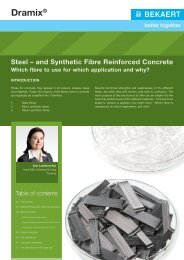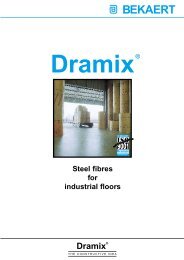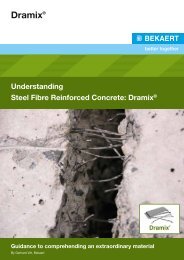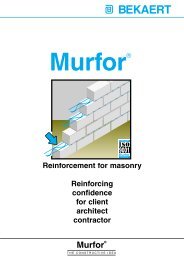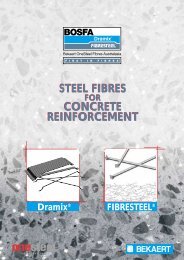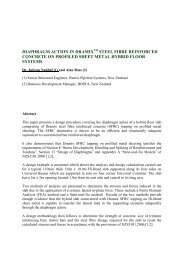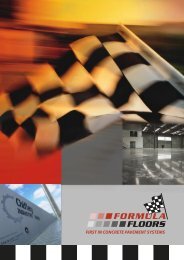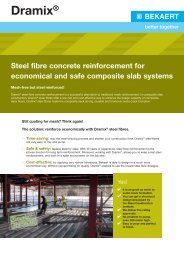punching shear resistance of steel fiber reinforced concrete ... - BOSFA
punching shear resistance of steel fiber reinforced concrete ... - BOSFA
punching shear resistance of steel fiber reinforced concrete ... - BOSFA
You also want an ePaper? Increase the reach of your titles
YUMPU automatically turns print PDFs into web optimized ePapers that Google loves.
The <strong>punching</strong> <strong>shear</strong> <strong>resistance</strong> <strong>of</strong> test slabs is shown in Table 2. See that, <strong>steel</strong> <strong>fiber</strong>s increase<br />
considerably <strong>punching</strong> <strong>shear</strong> capacity <strong>of</strong> slabs and this increase is directly proportional to <strong>fiber</strong><br />
volume. Adding from 30 to 60 kg/m 3 <strong>steel</strong> <strong>fiber</strong>s to <strong>concrete</strong>, increase the <strong>punching</strong> <strong>shear</strong> <strong>resistance</strong><br />
from 16.2 to 39.8% for slabs in group A. For slabs in group B, this increase ranges in 9.0 to 15.3%,<br />
and in 16.3 to 23.5% for the ones in group C. The increase <strong>of</strong> <strong>punching</strong> <strong>shear</strong> capacity <strong>of</strong> SFRC<br />
slabs is because <strong>of</strong> <strong>steel</strong> <strong>fiber</strong>s help to bridge cracks in the whole <strong>concrete</strong> volume and transfer<br />
tensile stress through two opposite faces <strong>of</strong> cracks until the <strong>fiber</strong>s are totally pulled-out or broken.<br />
For this reason, in stage <strong>of</strong> initiation and propagation <strong>of</strong> cracks, tensile zone <strong>of</strong> SFRC slabs still<br />
sustains load. This increases <strong>concrete</strong> tensile strength and indirectly leads to increase the <strong>punching</strong><br />
<strong>shear</strong> <strong>resistance</strong> <strong>of</strong> slabs. Fig. 5 shows clearly effect <strong>of</strong> <strong>fiber</strong> volume on the <strong>punching</strong> <strong>shear</strong> capacity<br />
<strong>of</strong> test slabs.<br />
Force V (KN)<br />
350<br />
300<br />
250<br />
200<br />
150<br />
100<br />
50<br />
0<br />
C0-1.5x1.5m (0 kg/m3)<br />
C1-1.5x1.5m (30kg/m3)<br />
C2-1.5x1.5m (45kg/m3)<br />
C3-1.5x1.5m (60kg/m3)<br />
0 0.2 0.4 0.6 0.8<br />
Average crack width w (mm)<br />
Figure 4: Typical load-crack width relationships<br />
<strong>of</strong> test slabs<br />
4. EVALUATION OF EXISTING FORMULAS<br />
Fiber volume V f (kg/m 3 )<br />
Figure 5: Effect <strong>of</strong> <strong>fiber</strong> volume on increase <strong>of</strong><br />
<strong>punching</strong> <strong>shear</strong> <strong>resistance</strong> <strong>of</strong> slabs<br />
This section provides evaluation <strong>of</strong> accuracy <strong>of</strong> existing formulas used to predict the <strong>punching</strong> <strong>shear</strong><br />
capacity <strong>of</strong> SFCR flat slabs proposed by Harajli (Harajli et al. 1994), Shaaban and Gesund (Shaaban<br />
and Gesund 1994) and Choi (Choi et al. 2007) using results <strong>of</strong> 73 test slabs <strong>of</strong> previous (Swamy and<br />
Ali 1982; Alexander and Simmonds 1992; Theodorakopoulos and Swamy 1993; Harajli et al. 1994;<br />
McHarg et al. 2000; Cheng and Montesinos 2010a) and authors’s tests. These 73 experimental<br />
results were obtained from the <strong>punching</strong> <strong>shear</strong> tests <strong>of</strong> SFRC flat slabs with different <strong>concrete</strong><br />
strength (from 12.4 to 59.4MPa), effective depth <strong>of</strong> slab (from 39 to 139mm), span to effective<br />
depth ratio (from 8 to 20), tensile reinforcement ratio (from 0.26 to 1.46%), <strong>fiber</strong> volume (from 0 to<br />
2%), <strong>fiber</strong> length to diameter ratio (from 0 to 100), and <strong>fiber</strong> types. The slabs were all simply<br />
supported. They cover a relatively wide spectrum <strong>of</strong> the material and geometric properties <strong>of</strong> SFRC<br />
slabs used in practice. All <strong>of</strong> these slabs failed in <strong>punching</strong> <strong>shear</strong>. Average value (Mean), standard<br />
Increase <strong>of</strong> <strong>punching</strong> <strong>shear</strong> capacity (%)<br />
45<br />
40<br />
35<br />
30<br />
25<br />
20<br />
15<br />
10<br />
5<br />
0<br />
Group A-0.9x0.9m<br />
Group B-1.2x1.2m<br />
Group C-1.5x1.5m<br />
0 20 40 60 80<br />
6




